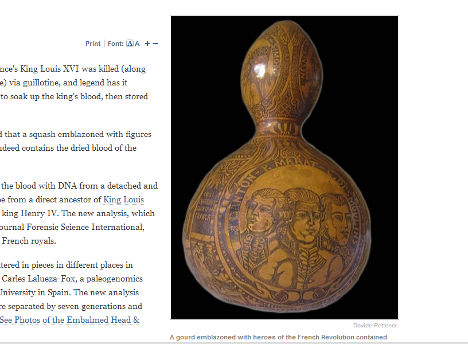Blood on cloth didn't belong to King Louis XVI

Scientists say a morbid souvenir from the execution of France's last king, a cloth dipped in his blood, is a fake. The long controversial keepsake has previously been verified as containing the blood of Louis XVI.
Two centuries after the French people beheaded King Louis XVI and dipped their handkerchiefs in his blood, DNA analysis has thrown new doubt on the authenticity of one such rag kept as a morbid souvenir.
The contents of an ornately-decorated gourd alleged to hold traces of the king's dried blood has long been the subject of scientific disagreement, with tests throwing up contradictory results.
On Thursday, a team from Europe and the United States said they had sequenced the full genome of the DNA in the squash, and found it was unlikely to be from someone tall or blue-eyed -- both features ascribed to the 18th century monarch.
"The results of these analyses do not support the royal identity of the sequenced genome," the authors concluded in a study in the journal Nature Scientific Reports.
Researchers have been trying for years to verify a claim imprinted on the calabash that: "On January 21, Maximilien Bourdaloue dipped his handkerchief in the blood of Louis XVI after his decapitation" in Paris in 1793.
He is then said to have placed the fabric in the dried, hollow gourd and had it embellished with portraits of revolutionary heroes.
In 2010, a study said DNA analysis of blood traces found inside the ornate vegetable revealed a match for someone of Louis' description, including his blue eyes.
One of the authors of that paper, Carles Lalueza-Fox of the Institute of Evolutionary Biology in Barcelona, also participated in the latest study, which contradicts the blue-eyed finding.
He told AFP the latest DNA analysis was much more complete: "we have now the whole genome of the person (in) the gourd."

(Screengrab/NBC News)
It's in the eyes
Lalueza-Fox said about 76 percent of the DNA in the calabash belonged to a single person whose genetic signature, from northern Italy, was not "compatible" with Louis' known, more central-European ancestry.
The individual likely had brown eyes and was of average height -- contrary to the king's description as the tallest person in the royal court.
In 2012, Lalueza-Fox had co-authored yet another paper concluding the blood in the gourd was indeed from Louis -- based on DNA shared with a mummified head said to belong to the king's predecessor, Henri IV.
By drawing a paternal genetic link between the remains of two men separated by over seven generations, Lalueza-Fox and French expert Philippe Charlier said at the time they had authenticated both royal relics -- a finding now seemingly thrown into doubt.
Royal connection?
Several other studies have found evidence for the head belonging to Henri-- physical features matching portraits of the king, as well as data from radiocarbon dating, 3D scanning and X-rays.
But research led by Belgian geneticist Jean-Jacques Cassiman last year found no genetic link between the DNA of living relatives of the Bourbon kings and the remains in the gourd or the mummified head.
Henri was assassinated by a fanatic Catholic in 1610, and his head is believed to have been saved from the ransacking of the royal chapel at Saint-Denis, north of Paris, during the French Revolution.
Charlier told AFP the link he and Lalueza-Fox had found between the two specimens "may have been coincidental".
"It does not place into doubt the authenticity of the head of Henri IV," he insisted.
Lalueza-Fox said the remaining 24 percent of DNA found in the gourd belonged to at least three other people who had touched the handkerchief -- but none had any Bourbon DNA markers either.
"It could still be possible, although implausible, that the gourd's blood could be that of the French king," the study concluded.
Hank Greely, a genetics ethics expert at Stanford University, said he doubted this was the end of the blood saga.
"Fundamentally, though, this is how science works. People do studies, they agree or disagree... they get followed up with more and better to see why and how there were differences -- and who, if anyone, was right."
Comments
See Also
Two centuries after the French people beheaded King Louis XVI and dipped their handkerchiefs in his blood, DNA analysis has thrown new doubt on the authenticity of one such rag kept as a morbid souvenir.
The contents of an ornately-decorated gourd alleged to hold traces of the king's dried blood has long been the subject of scientific disagreement, with tests throwing up contradictory results.
On Thursday, a team from Europe and the United States said they had sequenced the full genome of the DNA in the squash, and found it was unlikely to be from someone tall or blue-eyed -- both features ascribed to the 18th century monarch.
"The results of these analyses do not support the royal identity of the sequenced genome," the authors concluded in a study in the journal Nature Scientific Reports.
Researchers have been trying for years to verify a claim imprinted on the calabash that: "On January 21, Maximilien Bourdaloue dipped his handkerchief in the blood of Louis XVI after his decapitation" in Paris in 1793.
He is then said to have placed the fabric in the dried, hollow gourd and had it embellished with portraits of revolutionary heroes.
In 2010, a study said DNA analysis of blood traces found inside the ornate vegetable revealed a match for someone of Louis' description, including his blue eyes.
One of the authors of that paper, Carles Lalueza-Fox of the Institute of Evolutionary Biology in Barcelona, also participated in the latest study, which contradicts the blue-eyed finding.
He told AFP the latest DNA analysis was much more complete: "we have now the whole genome of the person (in) the gourd."

(Screengrab/NBC News)
It's in the eyes
Lalueza-Fox said about 76 percent of the DNA in the calabash belonged to a single person whose genetic signature, from northern Italy, was not "compatible" with Louis' known, more central-European ancestry.
The individual likely had brown eyes and was of average height -- contrary to the king's description as the tallest person in the royal court.
In 2012, Lalueza-Fox had co-authored yet another paper concluding the blood in the gourd was indeed from Louis -- based on DNA shared with a mummified head said to belong to the king's predecessor, Henri IV.
By drawing a paternal genetic link between the remains of two men separated by over seven generations, Lalueza-Fox and French expert Philippe Charlier said at the time they had authenticated both royal relics -- a finding now seemingly thrown into doubt.
Royal connection?
Several other studies have found evidence for the head belonging to Henri-- physical features matching portraits of the king, as well as data from radiocarbon dating, 3D scanning and X-rays.
But research led by Belgian geneticist Jean-Jacques Cassiman last year found no genetic link between the DNA of living relatives of the Bourbon kings and the remains in the gourd or the mummified head.
Henri was assassinated by a fanatic Catholic in 1610, and his head is believed to have been saved from the ransacking of the royal chapel at Saint-Denis, north of Paris, during the French Revolution.
Charlier told AFP the link he and Lalueza-Fox had found between the two specimens "may have been coincidental".
"It does not place into doubt the authenticity of the head of Henri IV," he insisted.
Lalueza-Fox said the remaining 24 percent of DNA found in the gourd belonged to at least three other people who had touched the handkerchief -- but none had any Bourbon DNA markers either.
"It could still be possible, although implausible, that the gourd's blood could be that of the French king," the study concluded.
Hank Greely, a genetics ethics expert at Stanford University, said he doubted this was the end of the blood saga.
"Fundamentally, though, this is how science works. People do studies, they agree or disagree... they get followed up with more and better to see why and how there were differences -- and who, if anyone, was right."
Join the conversation in our comments section below. Share your own views and experience and if you have a question or suggestion for our journalists then email us at [email protected].
Please keep comments civil, constructive and on topic – and make sure to read our terms of use before getting involved.
Please log in here to leave a comment.